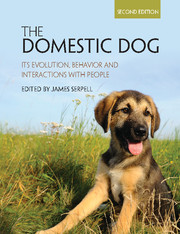Book contents
- Frontmatter
- Dedication
- Contents
- List of contributors
- 1 Introduction
- PART I ORIGINS AND EVOLUTION
- PART II BEHAVIOR, COGNITION AND TRAINING
- PART III DOG-HUMAN INTERACTIONS
- 13 Dogs as helping partners and companions for humans
- 14 The welfare of dogs in human care
- 15 From paragon to pariah: Cross-cultural perspectives on attitudes to dogs
- PART IV LIFE ON THE MARGINS
- Index
- Plate section
- References
15 - From paragon to pariah: Cross-cultural perspectives on attitudes to dogs
from PART III - DOG-HUMAN INTERACTIONS
Published online by Cambridge University Press: 30 December 2016
- Frontmatter
- Dedication
- Contents
- List of contributors
- 1 Introduction
- PART I ORIGINS AND EVOLUTION
- PART II BEHAVIOR, COGNITION AND TRAINING
- PART III DOG-HUMAN INTERACTIONS
- 13 Dogs as helping partners and companions for humans
- 14 The welfare of dogs in human care
- 15 From paragon to pariah: Cross-cultural perspectives on attitudes to dogs
- PART IV LIFE ON THE MARGINS
- Index
- Plate section
- References
Summary
Introduction
Human attitudes to non-human animals (henceforth “animals”) are influenced by a variety of factors. For example, animals that are perceived to be economically or instrumentally beneficial to human interests are generally, though not invariably, viewed more positively than those that are seen to be detrimental. Thus, honey bees that make honey and pollinate crops are regarded more positively than cockroaches, even though bees can sting – sometimes fatally – and cockroaches cannot. Certain animals may also possess inherent characteristics of appearance or behavior that humans find appealing or repellant on a purely emotional level, independent of the animal's instrumental value. Butterflies, for instance, tend to be liked for purely aesthetic reasons, while snakes are commonly loathed, despite the latter playing an important role in the control of agricultural pests. Animals are also “culturally constructed” in the sense that they acquire a wealth of symbolic and metaphorical associations and meanings that are peculiar to particular cultural settings. For example, the “sacred” status of cows in India is a cultural construct derived from Hindu religion that contrasts markedly with attitudes to cattle in, say, Europe or North America (Serpell, 1996, 2004).
Western attitudes to animals are colored by a strong sense of human exceptionalism that has its roots in the traditional Judaeo-Christian worldview. According to this perspective, humans and other animals were produced by separate acts of divine creation; the former to rule over the latter, and the latter to serve the exclusive interests of the former (Midgley, 1983; Serpell, 1996, 2005; Thomas, 1983). Despite such traditions, it is nonetheless clear that the distinction between human and non-human can become blurred under certain circumstances, such as when human victims of political or racial oppression find themselves summarily reclassified as “animals” preparatory to having their legal and moral rights ignored or denied (see e.g. Arluke & Sax, 1992). Occasionally, the barrier can also be penetrated from the opposite direction. Just as people are sometimes classified as animals, so animals – for one reason or another – may be categorized and treated as persons. In the Middle Ages, dangerous animals and vermin were occasionally tried, tortured and executed for committing “crimes,” as if they were guilty of malicious intent and, like people, could be held morally accountable for their actions (Dinzelbacher, 2002; Evans, 1906; Girgen, 2003).
- Type
- Chapter
- Information
- The Domestic DogIts Evolution, Behavior and Interactions with People, pp. 300 - 316Publisher: Cambridge University PressPrint publication year: 2016
References
- 4
- Cited by



